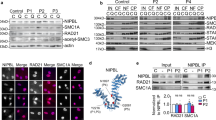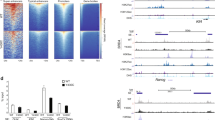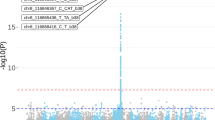Abstract
Transcriptional elongation is critical for gene expression regulation during embryogenesis. The super elongation complex (SEC) governs this process by mobilizing paused RNA polymerase II (RNAP2). Using exome sequencing, we discovered missense mutations in AFF4, a core component of the SEC, in three unrelated probands with a new syndrome that phenotypically overlaps Cornelia de Lange syndrome (CdLS) that we have named CHOPS syndrome (C for cognitive impairment and coarse facies, H for heart defects, O for obesity, P for pulmonary involvement and S for short stature and skeletal dysplasia). Transcriptome and chromatin immunoprecipitation sequencing (ChIP-seq) analyses demonstrated similar alterations of genome-wide binding of AFF4, cohesin and RNAP2 in CdLS and CHOPS syndrome. Direct molecular interaction of the SEC, cohesin and RNAP2 was demonstrated. These data support a common molecular pathogenesis for CHOPS syndrome and CdLS caused by disturbance of transcriptional elongation due to alterations in genome-wide binding of AFF4 and cohesin.
This is a preview of subscription content, access via your institution
Access options
Subscribe to this journal
Receive 12 print issues and online access
$209.00 per year
only $17.42 per issue
Buy this article
- Purchase on Springer Link
- Instant access to full article PDF
Prices may be subject to local taxes which are calculated during checkout





Similar content being viewed by others
References
Lin, C. et al. Dynamic transcriptional events in embryonic stem cells mediated by the super elongation complex (SEC). Genes Dev. 25, 1486–1498 (2011).
Yamaguchi, Y., Shibata, H. & Handa, H. Transcription elongation factors DSIF and NELF: promoter-proximal pausing and beyond. Biochim. Biophys. Acta 1829, 98–104 (2013).
Heidemann, M., Hintermair, C., Voß, K. & Eick, D. Dynamic phosphorylation patterns of RNA polymerase II CTD during transcription. Biochim. Biophys. Acta 1829, 55–62 (2013).
Lin, C. et al. AFF4, a component of the ELL/P-TEFb elongation complex and a shared subunit of MLL chimeras, can link transcription elongation to leukemia. Mol. Cell 37, 429–437 (2010).
Liu, J. & Krantz, I.D. Cornelia de Lange syndrome, cohesin, and beyond. Clin. Genet. 76, 303–314 (2009).
Gillis, L.A. et al. NIPBL mutational analysis in 120 individuals with Cornelia de Lange syndrome and evaluation of genotype-phenotype correlations. Am. J. Hum. Genet. 75, 610–623 (2004).
Deardorff, M.A. et al. Mutations in cohesin complex members SMC3 and SMC1A cause a mild variant of Cornelia de Lange syndrome with predominant mental retardation. Am. J. Hum. Genet. 80, 485–494 (2007).
Deardorff, M.A. et al. RAD21 mutations cause a human cohesinopathy. Am. J. Hum. Genet. 90, 1014–1027 (2012).
Deardorff, M.A. et al. HDAC8 mutations in Cornelia de Lange syndrome affect the cohesin acetylation cycle. Nature 489, 313–317 (2012).
Isaacs, A.M. et al. A mutation in Af4 is predicted to cause cerebellar ataxia and cataracts in the robotic mouse. J. Neurosci. 23, 1631–1637 (2003).
Oliver, P.L., Bitoun, E., Clark, J., Jones, E.L. & Davies, K.E. Mediation of Af4 protein function in the cerebellum by Siah proteins. Proc. Natl. Acad. Sci. USA 101, 14901–14906 (2004).
Luo, Z. et al. The super elongation complex family of RNA polymerase II elongation factors: gene target specificity and transcriptional output. Mol. Cell. Biol. 32, 2608–2617 (2012).
Sanders, S.J. et al. De novo mutations revealed by whole-exome sequencing are strongly associated with autism. Nature 485, 237–241 (2012).
O'Roak, B.J. et al. Exome sequencing in sporadic autism spectrum disorders identifies severe de novo mutations. Nat. Genet. 43, 585–589 (2011).
Urano, A. et al. Infertility with defective spermiogenesis in mice lacking AF5q31, the target of chromosomal translocation in human infant leukemia. Mol. Cell. Biol. 25, 6834–6845 (2005).
Tzschach, A. et al. Molecular cytogenetic analysis of a de novo interstitial deletion of 5q23.3q31.2 and its phenotypic consequences. Am. J. Med. Genet. A. 140, 496–502 (2006).
Sun, J. et al. Genetic and genomic analyses of RNA polymerase II–pausing factor in regulation of mammalian transcription and cell growth. J. Biol. Chem. 286, 36248–36257 (2011).
Yang, Z., Zhu, Q., Luo, K. & Zhou, Q. The 7SK small nuclear RNA inhibits the CDK9/cyclin T1 kinase to control transcription. Nature 414, 317–322 (2001).
Nguyen, V.T., Kiss, T., Michels, A.A. & Bensaude, O. 7SK small nuclear RNA binds to and inhibits the activity of CDK9/cyclin T complexes. Nature 414, 322–325 (2001).
Jang, M.K. et al. The bromodomain protein Brd4 is a positive regulatory component of P-TEFb and stimulates RNA polymerase II–dependent transcription. Mol. Cell 19, 523–534 (2005).
Yang, Z. et al. Recruitment of P-TEFb for stimulation of transcriptional elongation by the bromodomain protein Brd4. Mol. Cell 19, 535–545 (2005).
Taki, T. et al. AF5q31, a newly identified AF4-related gene, is fused to MLL in infant acute lymphoblastic leukemia with ins(5;11)(q31;q13q23). Proc. Natl. Acad. Sci. USA 96, 14535–14540 (1999).
Komori, T. et al. Regulation of AMP-activated protein kinase signaling by AFF4 protein, member of AF4 (ALL1-fused gene from chromosome 4) family of transcription factors, in hypothalamic neurons. J. Biol. Chem. 287, 19985–19996 (2012).
Liu, J. et al. Transcriptional dysregulation in NIPBL and cohesin mutant human cells. PLoS Biol. 7, e1000119 (2009).
Wendt, K.S. et al. Cohesin mediates transcriptional insulation by CCCTC-binding factor. Nature 451, 796–801 (2008).
Kagey, M.H. et al. Mediator and cohesin connect gene expression and chromatin architecture. Nature 467, 430–435 (2010).
Remeseiro, S. et al. Cohesin-SA1 deficiency drives aneuploidy and tumourigenesis in mice due to impaired replication of telomeres. EMBO J. 31, 2076–2089 (2012).
Remeseiro, S., Cuadrado, A., Gómez-López, G., Pisano, D.G. & Losada, A. A unique role of cohesin-SA1 in gene regulation and development. EMBO J. 31, 2090–2102 (2012).
Schaaf, C.A. et al. Genome-wide control of RNA polymerase II activity by cohesin. PLoS Genet. 9, e1003382 (2013).
Lopez-Serra, L., Kelly, G., Patel, H., Stewart, A. & Uhlmann, F. The Scc2-Scc4 complex acts in sister chromatid cohesion and transcriptional regulation by maintaining nucleosome-free regions. Nat. Genet. 46, 1147–1151 (2014).
DePristo, M.A. et al. A framework for variation discovery and genotyping using next-generation DNA sequencing data. Nat. Genet. 43, 491–498 (2011).
Cingolani, P. et al. A program for annotating and predicting the effects of single nucleotide polymorphisms, SnpEff: SNPs in the genome of Drosophila melanogaster strain w1118; iso-2; iso-3. Fly (Austin) 6, 80–92 (2012).
Kon, A. et al. Recurrent mutations in multiple components of the cohesin complex in myeloid neoplasms. Nat. Genet. 45, 1232–1237 (2013).
Stasevich, T.J. et al. Regulation of RNA polymerase II activation by histone acetylation in single living cells. Nature 516, 272–275 (2014).
Porensky, P.N. et al. A single administration of morpholino antisense oligomer rescues spinal muscular atrophy in mouse. Hum. Mol. Genet. 21, 1625–1638 (2012).
Heredia, N.J. et al. Droplet DigitalTM PCR quantitation of HER2 expression in FFPE breast cancer samples. Methods 59, S20–S23 (2013).
Kim, D. et al. TopHat2: accurate alignment of transcriptomes in the presence of insertions, deletions and gene fusions. Genome Biol. 14, R36 (2013).
Trapnell, C. et al. Differential analysis of gene regulation at transcript resolution with RNA-seq. Nat. Biotechnol. 31, 46–53 (2013).
Komata, M. et al. Chromatin immunoprecipitation protocol for mammalian cells. Methods Mol. Biol. 1164, 33–38 (2014).
Langmead, B., Trapnell, C., Pop, M. & Salzberg, S.L. Ultrafast and memory-efficient alignment of short DNA sequences to the human genome. Genome Biol. 10, R25 (2009).
Nakato, R., Itoh, T. & Shirahige, K. DROMPA: easy-to-handle peak calling and visualization software for the computational analysis and validation of ChIP-seq data. Genes Cells 18, 589–601 (2013).
Mali, P. et al. RNA-guided human genome engineering via Cas9. Science 339, 823–826 (2013).
Acknowledgements
We thank K. Nakagawa, S. Watanabe and E. Rappaport for their technical assistance. This work was supported by a Grant-in-Aid for Scientific Research (S) and for innovative science from MEXT (Ministry of Education, Culture, Sports, Science and Technology) (K.S.) and by research grants from the CdLS Foundation, development funds from the Children's Hospital of Philadelphia and grant PO1 HD052860 from the US National Institutes of Health (NIH)/National Institute of Child Health and Development (NICHD) (I.D.K.).
Author information
Authors and Affiliations
Contributions
K.I. and I.D.K. initiated the human studies. K.I., S.N., K.G., J.S., E.H.Z., M.A.D., D.C., J.L.A. and I.D.K. characterized clinical data. K.I., M.C.D., R.R., C.P.V., M. Kaur and I.D.K. performed exome analysis and Sanger sequencing confirmation of the mutation. K.I., A.C.E., D.D., Z.M., M.B. and K.S. designed and performed the biochemical analyses. K.I. performed skin fibroblast expression studies and genome editing experiments. Z.Z. analyzed the skin fibroblast expression array data. R.N., M. Komata, M.B., Y.K. and K.S. performed ChIP-seq and RNA-seq and the accompanying bioinformatics analysis. K.I., K.S. and I.D.K. drafted the manuscript. All authors analyzed the data, discussed the results and commented on the manuscript.
Corresponding authors
Ethics declarations
Competing interests
The authors declare no competing financial interests.
Integrated supplementary information
Supplementary Figure 1 Sanger sequence chromatograms of AFF4 missense mutations.
Sanger sequence chromatogram demonstrating AFF4 missense mutations.
Supplementary Figure 2 Gene expression levels of immediate early response genes upon serum stimulation.
(a) FOS. (b) EGR1 expression level. (c) EGR1 fold induction upon serum stimulation.
Supplementary Figure 3 Statistics of expression arrays using CHOPS syndrome skin fibroblasts and Affymetrix U133plus2 chips.
Left top, P-value distribution. This plot shows the counts of genes whose SAM P values are located in each interval of 0.01. The leftmost bar indicates the number of genes having P values less than 0.01. If the data are completely random and there are enough samples, the P values will have a uniform distribution, with approximately the same number of genes in each interval. If there are indeed a number of genes differentially expressed between the compared groups and the microarray experiments are properly designed and executed, we expect the P values to have a distribution with the highest density on the left side. If the highest density of the distribution is in the middle or on the right side, we would suspect a confounding factor that has a bigger influence on the data than the factor distinguishing the two compared groups. Right top, FDR. This plot traces the number of genes corresponding to each FDR cutoff. The table lists the number of genes corresponding to commonly used FDR cutoffs.
Supplementary Figure 5 Total RNA-seq results.
(a) Comparison of expression array results for the Affymetrix Human Gene 2.0 ST array and total RNA-seq. Similarities of expression array and total RNA-seq profiles for CHOPS syndrome and CdLS are demonstrated. The left figure is the result for the control sample, and the right figure is the CHOPS syndrome sample. The x axis represents log2-transformed RPKM values, and the y axis represents gene expression levels on the expression array. (b,c) Dysregulated genes in total RNA-seq are correlated between CdLS and CHOPS syndrome. (d) Similarities of the transcriptome pattern for CHOPS syndrome probands. Comparing the transcriptome pattern of CHOPS T254A and CHOPS T254S samples to that for the control samples, we identified 309 differentially expressed genes in CHOPS T254A and CHOPS T254S. Then, we evaluated the expression pattern of these 309 genes in the CHOPS R258W sample, compared to the other CHOPS samples. The expression levels of dysregulated genes in CHOPS T254A and CHOPS T254S were similarly altered in CHOPS R258W. Left, comparison of CHOPS T254A and CHOPS T254S. Middle, comparison of CHOPS R258W and CHOPS T254S. Right, comparison of CHOPS R258W and CHOPS T254A.
Supplementary Figure 6 AFF4 mRNA expression levels and AFF4 mutant allele expression levels.
(a) mRNA levels of AFF4 in CHOPS syndrome and control samples. (b) Expression levels of the mutant AFF4 allele as compared to the wild-type (wt) AFF4 allele in CHOPS syndrome samples.
Supplementary Figure 7 Sanger sequencing result of CRISPR/cas9 introduction of AFF4 deletion.
Top, wild-type (WT) AFF4 exon 3 sequence. Middle, the CHOPS T254A AFF4-null clone had biallelic 2-bp deletion (CC) and 1-bp insertion (G) leading to the frameshift mutation. Bottom, the CHOPS T254A AFF4 mutant allele del clone had a 1-bp deletion (G) on the mutant AFF4 allele, and the wild-type AFF4 allele remained intact.
Supplementary Figure 8 ChIP-seq analysis of AFF4, RAD21, RNAP2 and SPT5.
(a) Positive correlation between RNAP2 Ser2ph and total RNA-seq levels for differentially expressed genes. Left, log ratio between the CHOPS syndrome sample and the healthy control. Right, log ratio between the CdLS sample and healthy control. Pearson’s correlation coefficients are shown. (b) Left, correlation between RNA-seq data and the unphosphorylated RNAP2 ChIP-seq profile in CHOPS T254A. Right, correlation between RNA-seq data and the unphosphorylated RNAP2 ChIP-seq profile in CDL006. (c) Left, correlation between RNA-seq data and the RNAP2 Ser5ph ChIP-seq profile in CHOPS T254A. Right, correlation between RNA-seq data and the RNAP2 Ser5ph ChIP-seq profile in CDL006. (d) Left, correlation between RNA-seq data and the SPT5 ChIP-seq profile in CHOPS T254A. Right, correlation between RNA-seq data and the SPT5 ChIP-seq profile in CDL006.
Supplementary Figure 9 ChIP-seq analysis of RAD21 and AFF4.
(a) RAD21 and AFF4 ChIP-seq results for the CHOPS syndrome sample. The yellow line indicates the result for the CHOPS T254A sample, the blue line indicates the result for the CdLS sample (CDL006) and the red line indicates the result for the control sample. More pronounced peak differences are seen in the upregulated genes in CHOPs syndrome (left column). Among the upregulated genes in CHOPS syndrome, higher RAD21 and AFF4 peaks at TSSs are seen. (b) RAD21 and AFF4 ChIP-seq results for the CdLS sample. As in a, peak differences are more pronounced for upregulated genes in the CdLS sample, and higher RAD21 and AFF4 peaks are seen around the TSSs.
Supplementary Figure 10 Correlation between AFF4 peaks and gene transcription.
Absence of correlation between AFF4 and RNAP2 ser2ph (top) and between AFF4 and total RNA-seq (bottom). Left and right panels show the differentially expressed genes in the CHOPS syndrome and CdLS samples, respectively.
Supplementary Figure 11 Proposed working models of transcriptional regulation governed by SEC and cohesin interaction.
Top, during transcriptional elongation, STAG1-cohesin interacts with elongating RNAP2 as well as the SEC. Bottom, in CHOPS syndrome, because of the accumulation of AFF4 on chromatin, excessive transcriptional activation occurs due to the alteration of genome-wide binding patterns for both the SEC and cohesin. Blue arrows indicate increased recruitment of ELL2, cyclinT1 and CDK9 to the SEC.
Supplementary information
Supplementary Text and Figures
Supplementary Figures 1–11. (PDF 696 kb)
Supplementary Table 1
Clinical phenotype of the probands with CHOPS syndrome. (XLSX 12 kb)
Supplementary Table 2
Exome sequencing statistics. (XLSX 31 kb)
Supplementary Table 3
Differentially expressed gene list in CHOPS syndrome. (XLSX 83 kb)
Supplementary Table 4
Gene ontology term analysis. (XLSX 62 kb)
Supplementary Table 5
Total RNA-seq statistics. (XLSX 10 kb)
Supplementary Table 6
Differentially expressed gene list in CHOPS syndrome and CdLS by total RNA-seq. (XLSX 110 kb)
Supplementary Table 7
ChIP-seq statistics. (XLSX 10 kb)
Rights and permissions
About this article
Cite this article
Izumi, K., Nakato, R., Zhang, Z. et al. Germline gain-of-function mutations in AFF4 cause a developmental syndrome functionally linking the super elongation complex and cohesin. Nat Genet 47, 338–344 (2015). https://doi.org/10.1038/ng.3229
Received:
Accepted:
Published:
Issue Date:
DOI: https://doi.org/10.1038/ng.3229
This article is cited by
-
Molecular landscape of congenital vertebral malformations: recent discoveries and future directions
Orphanet Journal of Rare Diseases (2024)
-
Identification of novel microRNAs in the embryonic mouse brain using deep sequencing
Molecular and Cellular Biochemistry (2024)
-
Context-dependent perturbations in chromatin folding and the transcriptome by cohesin and related factors
Nature Communications (2023)
-
The multifaceted roles of cohesin in cancer
Journal of Experimental & Clinical Cancer Research (2022)
-
Large-scale multi-omics analysis suggests specific roles for intragenic cohesin in transcriptional regulation
Nature Communications (2022)



